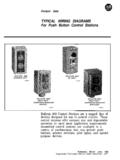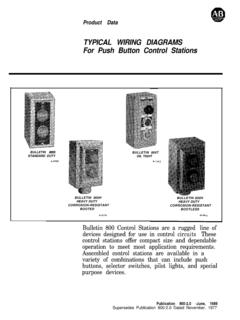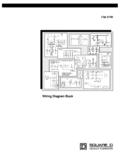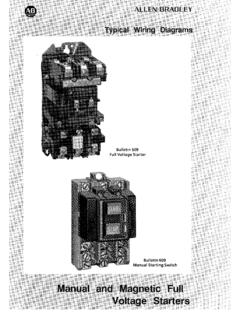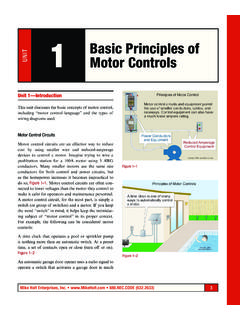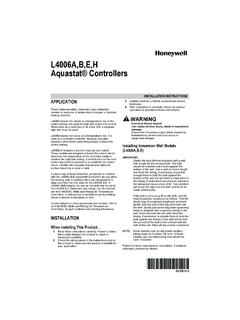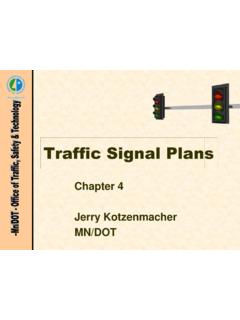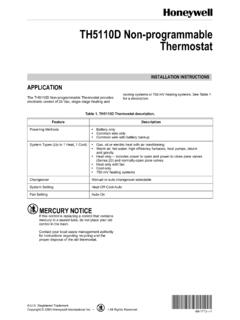Transcription of Switch Machines Installation & Wiring - Palmetto Div
1 Switch Machines Installation & Wiring Conventional Twin Coil Switch Machines In use since developed by Walthers in early 1930's Long time standard for remote operation Currently: Rix, Atlas, etc. Electrically: 12-24 v AC or DC. Brief, high current (~2-5 ohm coils) yields brief power pulse, requires heavy wire Difficult to fire more than 2 or 3 at the same time ? If any available today have reliable electrical contacts Bad things happen if power stays on Most capacitive discharge powers supplies are fail safe tortoise (Stall Motor) Machines Electrically: 12 VDC Stall Motor DPDT Switch Continuous low current (~20 ma) allows light Wiring 20 ma ideal to power LED In series with tortoise Relatively long throw, continuous force while power on Slow, realistic turnout motion Two sets reliable SPDT contacts Carry 4 amps, Switch 1 amp Frog power, signals, panel lights, etc tortoise contacts: Tell signals which way Turnout is thrown Control frog & point polarity Can also power LEDs on panel, etc Normal Installation tortoise Directions Modified Installation 1/4" to 3/8 hole wire, bent as directed wire, ~1/16.
2 L at top end brass, 3/8 x , drilled 3/32 for screw, 1/16 ID collar soldered on 10 pos printed circuit edge connector brass, 1/16 hole, pivot . Spring wire #4 pan head Two 1/16 ID collars metal screws soldered together *. brass, 3/8 x 1/2 . 3/32 drill for SM screw, Typical Offset Installation 1/16 ID collar soldered on Brass scrap pivot, 1/16 hole spring wire brass scrap soldered onto wire, 1/16 ID collar Brass, 3/8 x1/2 , 3/32 Drill for SM screw, 1/16 ID Collar soldered on Typical offset tortoise mount SM mounted with #4 pan head screws A tortoise can be mounted in almost any position, along as the motion is approximately at right angles to the track Possible alternative linkage If no hole under turnout: From Feb 2010 RMC. Consider wire for Lower arm, spring action Same Principles work for Twin Coil Machines 12 volts in, out 12 volts in, out Be aware: If you wire your own power supply, you might not get the output voltage you expect!
3 LED's on panel to show turnout position The position of a single turnout can be shown with two LED's in parallel in a wire to the tortoise . The lighted LED will be dim until the tortoise motor stalls, then go bright. You can also indicate a single turnout by grounding the LED. through a tortoise contact. Wiring LED's in line is usually simpler. This can also be used for a route if you wish to show the position of every turnout. To show the route selected with a single LED, the LED is powered at the panel and grounded through contacts on the tortoise Machines . This gives a CTC feel to the panel. push the button , hear the Switch Machines operate, and the LED lights only after all turnouts are aligned to the desired route. Wiring - Suggestions Use PCB edge connectors to wire tortoise No risk of damage to circuit board, can make layout connections more accessible Use two power supplies and common ground Wire LEDs for position indication in this order: +12 vdc 560 ohms (LED life 30,000 hours @ 25 ma, about sec @ 12 volts!)
4 Make 9 volt battery/330 ohm resistor/LED tester . Get a multimeter (reads volts, ohms, ma, more). Magic words are digital and autoranging . About $25 and up (way up!) at Radio Shack or Lowes Add PCB Edge Connector Allows remote (and accessible) layout connections 10 Position Connectors were $ at All Electronics Easy removal w/o risk of board damage Layout connections at more accessible location Use two power supplies w/. Common ground LEDs (optional). (indicate Switch position + SPDT Switch 12 volts 12 vdc - tortoise DC. +. 12 vdc - Common ground wire Makes Wiring much simpler, only one wire to each tortoise Common ground not for DCC, but helpful for accessory Wiring Common ground wire not shown in Wiring diagrams Switch can be toggle, rotary, slide, or relay Beware of make before break switches! Simple Electrical Tester LED (any). Here to ground, check continuity, etc Here to ground to check LED's 330 ohm resistor 9 volt battery Check which contacts are closed on tortoise , relays, etc Can also test transistors, on PNP, P to N (emitter and collector to base) should conduct, N to P should not.)
5 NOTE: 3 volt battery, 100 ohm resistor safer, LED's not rated for 9 volts in reverse My layouts used rotary switches for twin coil Switch Machines . Turn knob then push button , knob showed turnout position. This technique worked well for years before changing to tortoise Machines . LEDs indicate turnout position Rotary switches for turnout control Buttons leftover from old twin solenoid 4 pole 3 pos. Rotary Switch Machines Controls turnout and wye tail Track polarity, center is track off Reversing for tail track Not needed Control Panel for Hidden Staging Yard Direction (Reversing Section). Occupancy (Entrance Section) Track Power Red LEDs show track occupancy Rotary Switch (3 pole 4 Pos) Green LED's show turnout Controls 3 Turnouts alignment Staging Yard tortoise Wiring Track Layout T-C Tk 4 +12 VDC. Tk 3 LED. Tk 2. T-A Tk 1 560 Ohms T-B. + 12 VDC. A. + 12 VDC.
6 -12 VDC. -12 VDC. + 12 VDC C. 3 Pole 4 Pos Rotary Switch -12 VDC B Each Pole shown separately These are for twin coil Machines Same circuit, rev. section Conventional Wiring Simple transistor/relay circuits operated by push buttons on this panel permit controlling Tortoises from several locations and via a diode matrix, route selection. The LED's show turnout position and/or route selected. Turnout Control from Multiple Locations and Route Selection On following circuits, while one button is shown, any number of buttons can be wired in parallel to control the relay (and tortoise ). from several locations. The first three circuits default to the relay off turnout position when layout power is turned off or interrupted. All Circuits can be used for anything that requires operating a relay from several locations PC relays require care in soldering connections to avoid overheating and damaging relay Simple Transistor Circuit Resistor allows transistor to conduct -12 volts DC To tortoise Per Transistor specs, +12 volts DC.
7 Up to 5000 ohms OK. Diode Stick contacts 1N4004 *. On button powers relay, stick contacts hold it on On Relay 12 volt Relay 150 ohm coil *. Off Off button shorts . relay coil, so it drops out PNP Transistor Resistor 2N3906 (All Elect.). 1500 ohms RS 276-1604. * not critical Two 3 amp Power Supplies Diode Matrix to select turnouts Transistor circuits to control turnouts Control tortoise with 5 volt Relay (No personal experience). -12 volts DC To tortoise On button powers relay, stick contact +12 volts DC. holds it on Relay stick . Off button contacts bypasses relay coil so it drops out Can have any no. of On on & off buttons in Relay parallel Relay Off AE RLY-538. Resistor matched to 5 v 178 ohm relay coil so about 7. volt drop, watt at 12 Resistor DPDT. volts 270 ohms watt Relays $1 to $ ea. at All Electronics Hysteresis Circuit (no personal experience). -12 volts DC To tortoise +12 volts DC.
8 This relay pulls in at 6 volts, drops out at 3 volts Off 300 ohm resistor selected so Relay volts on relay coil On Resistor must be matched to relay coil Beware that if both buttons are pushed at once, a short will result. There should be some sort of current limiter in circuit (eg, an auto taillight bulb. Latching Relays A relay an electromechanical Switch . It is used to control a large current with a small current. Most relays require a small continuous control current to stay on. A latching relay is different. It uses a voltage pulse to cycle the relay, then stays in this position until the opposite control voltage is applied. The latching relay has a small metal strip which can pivot between two terminals. The Switch is magnetized, or attached to a small magnet. On either side of that magnet are small coils of wire. The two coils are used to control the relay.)
9 When electric current flows into one coil, it generates a magnetic field, which moves the Switch from one side to the other. When the power is removed from the coil, the strip stays there until it receives a magnetic pulse in the opposite direction. This may come either from the other coil or from a current with the opposite polarity in the original coil, pushing the Switch back to the other terminal. $ ea. Latching Relay - Typical Sample from Digikey Catalog Use set & reset coils to reverse Permits multiple control locations &. Route control w/diode matrix IE very simple, versatile But 10 terminals on 9/16 x 5/16 base Panel for Latching Relays Power, +, gnd, - 12 vdc Relay To Switch Machines #24 wire relay to pin Escutcheon Pins Handy as terminals Input from Panel Buttons Track Schematic (Diode matrix under HS tubing). Susquehanna Panel (Modified since earlier slide).
10 Buttons select track, LED's show current turnout positions Further information is available (or comments, criticism, etc). Phone, email, or visit Hendersonville Gordon Fewster Ontario Southern Railway (828)692-5983.
